| | | Product Summary |
|---|
The 7Flex Monitor Arm is an affordable, reliable gas-cylinder articulating arm which provides effortless adjustment of monitors in all three planes. It offers superior adjustability when compared with many other entry-level monitor arms: 16" of vertical range, 23.4" of horizontal reach, 360° of rotation at 3 joints; 200° of monitor tilt, and monitor pivot from portrait to landscape. This arm supports monitors between 7 and 17 pounds in weight and comes with a universal FLEXmount which includes 6 different mounting configurations: desk clamp, through desk, wall mount, reverse wall mount, side bolt, and grommet hole clamp mount. The 7Flex can be folded away to take up only 2.9" of space, will work with any VESA-100 compatible monitor with the included quick-release mount, and includes plastic cable channels to improve cable management. This durable arm features a proven and reliable design and comes with a 10 year warranty.
7Flex vs 7500 Series Arms: The 7Flex Monitor Arm is an ideal all-purpose consumer-oriented arm, ideal for single-user environments where constant adjustment of the monitor is less frequent. The 7500 Deluxe Monitor Arm is a more robust arm capable of handling a broader range of applications, offers greater horizontal and vertical adjustment range and incorporates innovative internal cable management. This makes it popular in healthcare applications, office environments and situations where customers may be in close proximity to the monitor (i.e. offices where clients are met, point of sale applications, etc.), or deployments where adjustments are comparatively more frequent. | | Ergonomic Benefits |
|---|
Reduces the Risk of Neck Injury A primary risk factor for injury in an office setting is an improperly positioned monitor. A good articulating monitor arm will help eliminate that problem by allowing height adjustment for the monitor relative to the surface on which the keyboard and mouse are situated. The 7Flex Monitor Arm provides 16" of vertical adjustment and 24" of horizontal adjustment, making it easier to adjust the monitor height to an optimal position. SPECIAL NOTE FOR THOSE WITH MULTIFOCAL OR PROGRESSIVE LENSES: As those with multifocal lenses rely on the lower portion of their glasses for "near" vision, they generally require the monitor to be positioned at a much lower height than those with no glasses or who only have single-vision lenses. Failing to address this will force them into an uncomfortable extension at the neck, as they tilt their head back in order to be able to view out of the lower portion of their corrective eyewear. Those with multifocal lenses may be able to position their monitors far enough away for best viewing at the intermediate range. Doing so can mitigate the neck extension as it may eliminate the need to tilt the head.
Optimizes the Viewing Angle Monitors are best viewed when the screen is parallel to the face. The ideal angle of the monitor is not necessarily perpendicular to the desk in all cases, however, since some may feel more comfortable slightly tilting their head forward, especially when working in a standing position. Note: As the head tilts forward, there is typically increased weight and load placed on the muscles in the neck, and as such any flexion should be limited to no more than 10 degrees.
Facilitates Virtually Effortless Movement The 7Flex uses a gas spring to counterbalance the effects of gravity, allowing individuals to adjust their monitor both up and down using their fingertips. This ease of adjustment (regardless of whether the monitor arm is fully extended or contracted) removes a potential obstacle for those who would otherwise be unwilling to adjust their monitor as needed. This technology is superior to mechanical spring mechanisms which cannot provide consistent linear counterbalance through the full range of the arm.
Sit-Stand Workstation Adaptable There are several accessories which can convert the 7Flex arm into a sit-stand arm (normally used in conjunction with a sit-stand keyboard tray). Whether an additional 6" of height (or 12" or more) is required, these accessories (listed below under Accessories) will raise the mounting point of the 7Flex so that it can be used at both sitting and standing heights. For 6" of additional height, use the 6" extender pole (8171-6-104) that fits into the existing FLEXmount; for 10.75" of additional height, use the 14” model with through mount (8395-14-TM-104). Images showing the potential ranges with each option can be found in the image gallery.
Increases Desktop Space By elevating the monitor above the worksurface, previously inaccessible desktop space is made available for storage and other office accessories (phones, calculators, etc.).
Eliminates Glare Adjusting the vertical and horizontal angle of the monitor will allow individuals to eliminate glare when viewing the monitor.
Helps Maintain Good Posture When Seated When a monitor is too low or high, people may choose to adjust the position of their torso instead of, or in addition to, their neck in an attempt to accommodate incorrect monitor height. This will often result in adopting a leaning forward posture, shifting them out of the ideal “S” posture in the spine, and losing any potential lumbar support that their chair provides. The correct monitor height may prevent this risk factor from arising.
Accommodates Working in Different Postures Movement is important! When a worker changes their posture between standing, lean-into, sitting, or leaning back in their chair the optimal position for their monitor(s) will change accordingly. The wide range of movement which the 7Flex provides will accommodate these new parameters, enabling them to correctly position their monitors for optimal viewing from any chosen posture.
Allows Multiple Individuals to Share Information Easily In some office environments workers need to share screen information with clients and/or co-workers, but this can be awkward or inconvenient when the monitor is on a stand and cannot easily be moved or oriented towards another person, even one sitting at the same desk. An articulating arm can easily solve this problem because the arm and monitor are easily pivoted to face even someone on the opposite side of a desk.
| | Features |
|---|
- Gas Spring: The gas cylinder completely counterbalances the weight of the monitor and arm, counteracting the effects of gravity.
- Vertical Range: The 7Flex offers a full 16" of vertical range, which is sufficient (if mounted at the ideal height) to provide an appropriate range for sit-stand adjustment for individuals up to 5'8" tall. If the arm is being mounted on a desktop for a sit-stand workstation, some kind of extension mount, such as the 7500 Series LCD Arm Extender (8395),will be required to elevate the arm to the ideal height. See the Table of Sit-Stand Heights to determine what amount of additional elevation may be required.
- Horizontal Extension: The 7Flex provides up to 23.4" of lateral reach, allowing the monitor to be brought all the way to the front edge of the desk when clamped at the back of a standard 24” deep desk.
- Universal FLEXmount: The included reconfigurable mount can be installed in 6 different configurations (see the assembly instructions), as indicated below, which will handle most mounting scenarios. Best of all, if it becomes necessary to change the way the arm is mounted several months after purchase, there is nothing more to buy - simply reconfigure the universal FLEXmount. This convertible mounting solution is also ideal for what can be challenging mounting scenarios for other arms such as thick desk edges, desk edges with longer trim and surfaces with a small lip. Additional mounting accessories are available to mount to financial trading slatwall, slotted panel furniture systems, and poles.
- Through the Desk - Bolt through the desk. Requires a 3/8" hole.
- Desk Edge (Using Clamp) - Clamps to the edge of the desk, no drilling required.
- Wall Mount - This heavy-duty wall mount will provide rock-solid security for the arm and monitor. Mounts vertically to the wall surface. Not recommended for dry wall, sheet rock or plaster surfaces.
- Reverse Wall Mount - An alternative mounting method
- Side Bolt (Panel System Rear Edge) - Mount to the solid side of a desk
- Grommet Hole Clamp Mount - For Grommets 2" and larger
- Monitor Tilter: The monitor tilter mechanism provides 200° of tilt adjustment at the head or wrist of the arm.
- Monitor Rotation: The monitor tilter mechanism provides 360° of monitor rotation allowing rotation from landscape to portrait orientation, even upside down (if required).
- Arm Rotates at 3 Joints: The 7Flex provides 360° of rotation at three joints, the base or "shoulder", the hinge or "elbow" and the end or "wrist". This yields almost limitless flexibility and articulating capabilities, allowing positioning of the monitor at any desired position.
- Compact Storage: When desired, the arm folds up to occupy only 3" of space, freeing up the entire desk for other activities.
- Cable Management: External Cable Guides provide cable management to prevent cables from dragging on the desk.
| | Images and Multimedia |
|---|
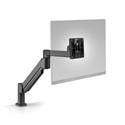
7Flex LCD Arm
| 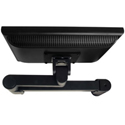
7Flex LCD Arm - top view, compact
| 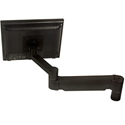
7Flex LCD Arm - back view, extended
| 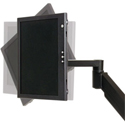
7Flex LCD Arm - landscape and portrait orientation
| 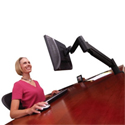
7Flex LCD Arm - in use
| 
7Flex with 6" Extension Pole (8171-6-104)
| 
7Flex with 14" Arm Extender (8395-14-TM-104)
| 
7Flex LCD Arm - Range of Motion
| |
| | Technical Specifications |
|---|
| | Usage Tips |
|---|
- Choose an Arm with an Appropriate Weight Capacity – Before purchasing your monitor arm, investigate the weight capacity of the arm so that the weight of your monitor is ideally in the middle of that range. For example, the weight capacity of the 7Flex is 7 to 17 lbs. The midrange weight is therefore 12 lbs. If your monitor happens to be about 12 lbs, the 7Flex should work fine for you. The closer to the midrange is the better. If you have not yet purchased a monitor or monitor arm, research your options and choose an arm that will work for the monitor you want. Obviously, if you already have an arm and not the monitor, you will have to choose a monitor with an appropriate weight without its stand included. In addition, you will have to choose a monitor that can be mounted on an arm with an acceptable hole pattern for mounting with screws. For the 7Flex, the monitor must have a hole pattern in the back side which is 100 mm x 100 mm square. Otherwise, you may require a special adapter plate.
- Select the Optimal Mounting Location – Since the 7Flex comes with a 6-in-1 configurable FLEXmount, you have ample options when it comes to mounting your monitor arm. Most people choose the desk clamping option but this only works if your desk has a lip on the mounting side and average depth (24-30"). Otherwise, a grommet mount or through mount is the next best option. You need a grommet hole of at least 2.25” diameter for the grommet mount to work, whereas the through mount requires that you drill a small hole in the desk to bolt the mount through the desk to secure it. You may want to roughly position the mount in different locations at first to get an idea of where the movement of the arm is optimal and then decide on which mounting option works best at that location.
- Adjust the Counterbalance Mechanism with Monitor Attached – After the 7Flex has been mounted in its optimal position, you will need to attach the monitor so that you can properly adjust the counterbalance mechanism. This will ensure that the monitor moves up or down effortlessly. Follow the manufacturer's instructions on how to do this, because if done improperly there may be damage to the balancing system. For the 7Flex, counterbalancing is done when the arm is extended or pushed down so that both arm segments are parallel to the desk. All hardware to do this calibrating is provided with the arm. After mounting, calibrating the counterbalance is the most critical step in installing your monitor arm properly. Once done, you are almost ready to use the monitor arm (see next tip).
- Become Familiar with the Adjustable Tension Points on the Joints of the Arm – To get the best movement out of your monitor arm, find all the critical joints where you are able to adjust the tension. These can be located using the Instruction Manual and are identified by the presence of a set screw. Allen wrenches are provided that can turn these set screws to vary the force needed to turn the arm at these critical joints. Often these joints are tightened during manufacturing to prevent any loose movement during shipment, so if your monitor arm seems stiff when swivelling at the base, for example, you may need to loosen the set screw at that point. Remember to store the hardware tools in a convenient place in order to make future adjustments quickly when needed.
- Set Monitor at Optimal Height, Angle, and Distance - Once your monitor arm has been installed and calibrated properly, you are ready to set it in the optimal position. In terms of ergonomic principles, the optimal position can vary, but there are definitely improper ways to set your monitor. Learn More About Optimizing Monitor Position.
| | Models |
|---|
| For related products, visit our online product listing. | | Model # | Description | Synnex SKU |
|---|
| 7Flex | 7Flex Monitor Arm, for monitors 7 to 17 lbs, Black | 5656322 | | 7Flex-HD | 7Flex-HD Monitor Arm, for monitors 13 to 28 lbs, Black | 5656330 | | 7000-1000-104 | 7000 Series Arm, for monitors 13 to 28 lbs, Black | |
| | Accessories |
|---|
| Model # | Description |
|---|
| 8171-6-104 | 6" Extender Tube, Black | | 8395-14-TM-104 | 7500 Series LCD Arm Extender, Through Mount, Black (14" above desk height) Original Price $400. Is now 65% off - $140.00 / unit !!! | | 7VESA1x2-603 | 100 mm x 200 mm VESA Adapter | | 8408-104 | Dual Arm Mount, Black | | 8409-104 | Handle Set for LCD Monitors, Black |
|
|